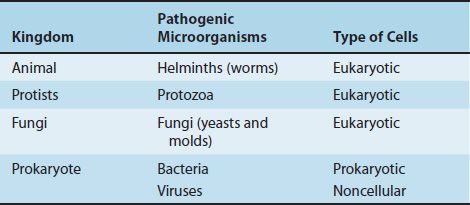1
Bacteria Compared with Other Microorganisms
CHAPTER CONTENTS
MICROBES THAT CAUSE INFECTIOUS DISEASES
The agents of human infectious diseases belong to five major groups of organisms: bacteria, fungi, protozoa, helminths, and viruses. Bacteria belong to the prokaryote kingdom, fungi (yeasts and molds) belong to the kingdom of fungi, and protozoa are members of the kingdom of protists. Helminths (worms) are classified in the animal kingdom (Table 1–1). Protists and fungi are distinguished from animals and plants by being either unicellular or relatively simple multicellular organisms. In contrast, helminths are complex multicellular organisms. Taken together, the helminths and the protozoa are commonly called parasites. Viruses are quite distinct from other organisms—they are not cells but can replicate only within cells.
TABLE 1–1 Biologic Relationships of Pathogenic Microorganisms

IMPORTANT FEATURES OF MICROBES
Many of the essential characteristics of these organisms are described in Table 1–2. One salient feature is that bacteria, fungi, protozoa, and helminths are cellular, whereas viruses are not. This distinction is based primarily on three criteria:
TABLE 1–2 Comparison of Medically Important Organisms

(1) Structure. Cells have a nucleus or nucleoid (see below), which contains DNA; this is surrounded by cytoplasm, within which proteins are synthesized and energy is generated. Viruses have an inner core of genetic material (either DNA or RNA) but no cytoplasm, and so they depend on host cells to provide the machinery for protein synthesis and energy generation.
(2) Method of replication. Cells replicate either by binary fission or by mitosis, during which one parent cell divides to make two progeny cells while retaining its cellular structure. Prokaryotic cells (e.g., bacteria) replicate by binary fission, whereas eukaryotic cells replicate by mitosis. In contrast, viruses disassemble, produce many copies of their nucleic acid and protein, and then reassemble into multiple progeny viruses. Furthermore, viruses must replicate within host cells because, as mentioned previously, they lack protein-synthesizing and energy-generating systems. With the exception of rickettsiae and chlamydiae, which also require living host cells for growth, bacteria can replicate extracellularly.
(3) Nature of the nucleic acid. Cells contain both DNA and RNA, whereas viruses contain either DNA or RNA but not both.
EUKARYOTES & PROKARYOTES
Cells have evolved into two fundamentally different types, eukaryotic and prokaryotic, which can be distinguished on the basis of their structure and the complexity of their organization. Fungi and protozoa are eukaryotic, whereas bacteria are prokaryotic.
(1) The eukaryotic cell has a true nucleus with multiple chromosomes surrounded by a nuclear membrane and uses a mitotic apparatus to ensure equal allocation of the chromosomes to progeny cells.
(2) The nucleoid of a prokaryotic cell consists of a single circular molecule of loosely organized DNA, lacking a nuclear membrane and mitotic apparatus (Table 1–3).
TABLE 1–3 Characteristics of Prokaryotic and Eukaryotic Cells

Stay updated, free articles. Join our Telegram channel

Full access? Get Clinical Tree


